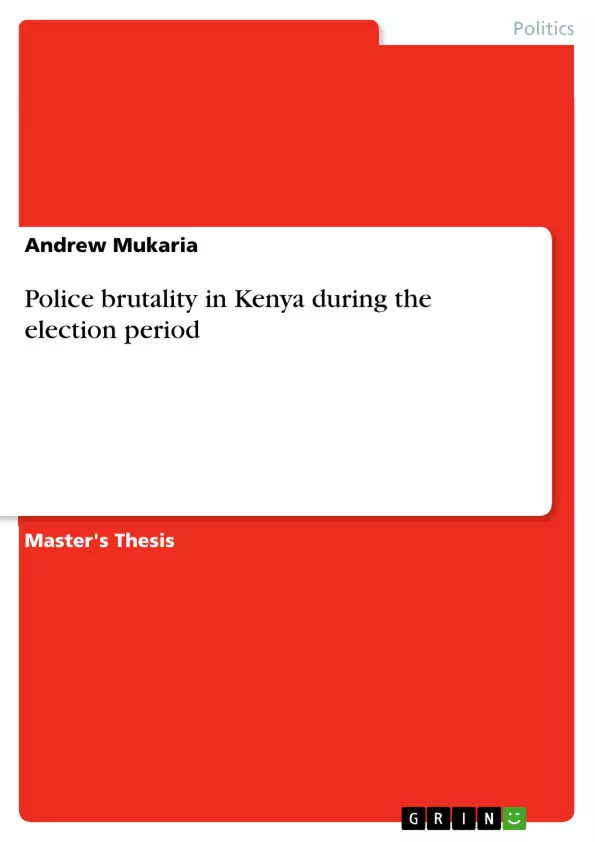This research explores cases of police brutality in Kenya during the election period. The study explores police brutality in post-police reform period from 2010-2018. It is a qualitatively done study through content analysis, mainly a review of the newspapers and articles detailing cases of police brutality in Kenya. These data are analysed thematically regarding the research question.
The findings of the research concerning the research question found that the police brutality is still happening in Kenya, mostly during the elections period. The study further found that there is an ingrained culture of police brutality, which is influenced by historical, contemporary social-cultural and structural dimensions.
I concluded the study with implications of the findings, for the theory and the research. Further, the study suggests the reform policies within the context and adherence to the constitution. The proposal offers two approaches, from below and from above. The research suggests, one, an establishment of grassroots and, encourages community policing: two, review of the police recruitment and police training curriculum. Three, an increase of financial and human resources support to the Independent Policing Oversight Kenya (IPOA). Four, laying down proper parameter which will separate Police from executive authorities, and firth, addressing the socioeconomic status of the police officers.
Table of Contents
- Chapter 1
- Introduction
- Background of study
- Statement of problem
- Research objective and Research question
- Significance of study
- Research Methodology
- Theoretical framework
- Related literature review
- Research outline
- Chapter 2
- Political (electoral), and socio-economic context in Kenya
- Political (electoral) Context
- Socio-economic context
- Human rights instruments and policing in Kenya
- Chapter 3
- History of partisan policing in Kenya
- Colonial Period
- Independent period
- Chapter 4
- Data analysis-cases of police brutality
- Peaceful demonstrations disrupted violently by the police
- Curfews, harassment, beatings and killings by the police officers
- Arbitrary arrests, detentions, intimidation, harassment of the opponent's party
- Chapter 5
- Discussing police brutality
- Dimensions of police brutality in Kenya
- Suggestion to the way forward
Objectives and Key Themes
This study delves into the persistent problem of police brutality in Kenya, aiming to understand its causes and potential solutions. It seeks to analyze the historical context, political and socio-economic factors, and structural dimensions of police brutality.
- Historical context of police brutality in Kenya
- Political and socio-economic factors contributing to police brutality
- Structural dimensions of police brutality
- Analysis of specific cases of police brutality
- Recommendations for addressing police brutality
Chapter Summaries
Chapter 1: Introduction introduces the topic of police brutality in Kenya, highlighting its prevalence and impact on citizens. It establishes the research objectives and methodology, outlining the theoretical framework and related literature review.
Chapter 2: Political (Electoral), and Socio-economic Context in Kenya examines the broader political and economic environment in which police brutality operates. This chapter explores the context of multi-party politics, socio-economic disparities, and the role of human rights instruments in policing.
Chapter 3: History of Partisan Policing in Kenya provides a historical overview of police brutality in Kenya, tracing its origins back to the colonial period and continuing through the post-independence era. This chapter examines the role of political regimes and their impact on police conduct.
Chapter 4: Data Analysis - Cases of Police Brutality presents an analysis of specific cases of police brutality, focusing on incidents of violent suppression of demonstrations, curfews, harassment, and arbitrary arrests.
Chapter 5: Discussing Police Brutality delves into the dimensions of police brutality in Kenya, examining its historical, contextual, and structural aspects. This chapter provides a multi-faceted understanding of the root causes of police brutality.
Keywords
Police brutality, Kenya, human rights, political context, socio-economic factors, historical analysis, data analysis, case studies, recommendations, structural dimensions, impunity, excessive force, citizen security, policing reform.
- Quote paper
- Dr/PhD in Ecotheology Andrew Mukaria (Author), 2019, Police brutality in Kenya during the election period, Munich, GRIN Verlag, https://www.grin.com/document/492590



